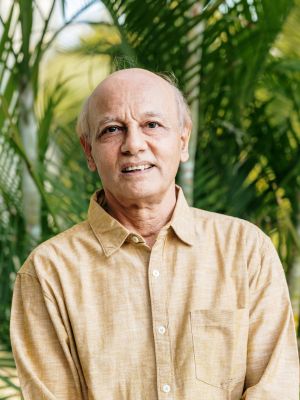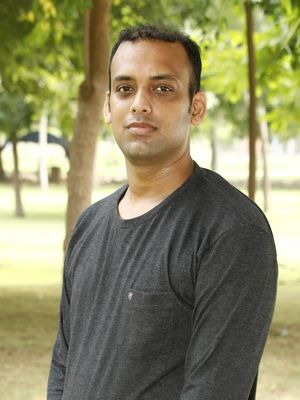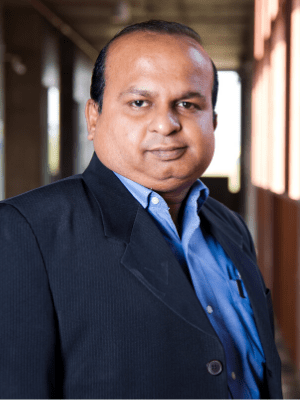Recently the World's Top 2% Scientists list by Stanford University featured five of our professors who are addressing some of the most critical issues of our times - policy making on sustainability and climate change mitigation, space and cosmology, nanodelivery of therapeutics, smart conditioning monitoring systems in industries, and body fluid detection in forensic investigations.
Here is a look at the work happening in their labs that reflects how they are exploring the new and addressing problems of the past and the present.

PRIYADARSHI SHUKLA
Distinguished Professor, Amrut Mody School of Management
Chair, Global Centre for Environment and Energy
What he is working on now:
Professor Priyadarshi Shukla's ongoing work as a member of the scientific steering committee of United Nations Environment Programme’s Emissions Gap Reports and the High-Level Commission on Carbon Prices for the World Bank focuses on the social cost of carbon and the social value of mitigation action. He and a team of researchers are conducting a high-resolution global assessment of rooftop solar photovoltaics potential and its growing role in the future global energy system using big data, machine learning, and geospatial analysis.
Professor Priyadarshi Shukla works at the forefront of sustainable development, energy, and environmental economics. He is Co-Chair of the Working Group III of the Intergovernmental Panel on Climate Change (IPCC), United Nations. His research focuses on mitigating climate change, delivering sustainable development goals, and policymaking focused on developing nations. He has authored several IPCC reports, including Global Warming of 1.5°C, Climate Change and Land, and Sixth Assessment Report of Working Group III on Mitigation of Climate Change.

PANKAJ JOSHI
Distinguished Professor of Physics, School of Arts and Sciences
Director, International Centre for Space and Cosmology
What he is working on now:
With studies on Accretion Disks and Shadow Shapes of Singularities, Professor Joshi is gathering evidence on the true nature of the Ultra dense object Sgr A* at the galactic centre. Is it a Black Hole or a Naked Singularity?
Professor Joshi is involved in extensive analysis of general relativistic gravitational collapse. His work has been widely recognised for providing insights into the final fate of massive collapsing stars in the universe, the formation of space-time singularities, and cosmic censorship. The Event Horizon Telescope collaboration that released its data and the photograph and images of our galactic centre, Sagittarius A*, earlier this year, cited the JMN model, also known as the Naked Singularity model, given in 2011 by Joshi, Malafarina, and Narayan, suggesting that the JMN model could be the best black hole mimicker.

ASHUTOSH KUMAR
Associate Professor, School of Arts and Sciences
What he is working on now:
Professor Kumar is working on clinical applications of nanomedicines and programmable DNA nanodevices to deliver therapeutic agents to targeted sites, specifically in knee joints. He is also researching zebrafish in his lab to assess the risk of nanotechnology and identify hazards to help in public policy.
Professor Kumar works on clinical applications of nanomedicines and programmable DNA nanodevices. His group works at the nano-bio interface, understanding the effects of nanotechnology on human life and the environment. He is interested in creating a novel, safe, effective, targeted nano-therapeutic that alleviates the requirement for a higher dosage of medication and side effects thereon for breast cancer and rheumatoid arthritis therapy. His research stands at the cusp of revolutionising not just the delivery and concentration of medication but also identifying pathways for imaging purposes. One of his other research interests is understanding the long-term effects of nanotechnology on living organisms.

AKHAND RAI
Assistant Professor, School of Engineering and Applied Science
What he is working on now:
Professor Rai is working on using artificial intelligence (AI) to enable automated and real-time fault detection in machinery, and detecting leaks in pipelines to ensure safety and reduce economical losses. He is also developing a technique using AI to predict the remaining useful life (RUL) of lithium-ion batteries, the early estimate of which will ensure consistent energy supply and efficient energy utilisation.
Professor Rai’s core interest areas are condition monitoring, fault diagnosis, and prognosis of rotating machinery. He works on extending the diagnosis practices to prognosis as a predictive maintenance strategy. Over the past five years, he has developed various signal processing and AI techniques using machine vibration data to enable automated and real-time fault detection. Apart from rotating machines, he has recently been focusing on diagnosing leaks in pipelines, having developed various robotics and AI-based techniques for pipeline leak detection and localisation using Acoustic Emission technology. This research can revolutionise the application of smart condition monitoring systems in industries and achieve the goals of Industry 4.0. In addition, he has been working on predictive maintenance for other systems also, such as Lithium-ion batteries, a key component in electric vehicles, for early detection of faults.

RITESH SHUKLA
Assistant Professor, School of Arts and Sciences
What he is working on now:
Professor Ritesh Shukla is working on speeding up and strengthening forensic investigations by developing a device for body fluid detection employing nanotechnology. His research will help not just accelerate investigation but also prevent DNA degradation, mitigating the challenges of partial DNA profiling.
With interest in interdisciplinary research in forensic science, Professor Ritesh Shukla assesses the biochemical and molecular markers for the ageing of biological stains. His lab aims to develop an on-field affordable point-of-detection device for body fluid identification to speed up investigation processes. The other part of his research focuses on developing a method for body fluid detection that can be used further for DNA analysis, even after the initial screening test. This procedure could potentially change how forensic investigations are carried out, enabling body fluid detection at the crime scene itself.